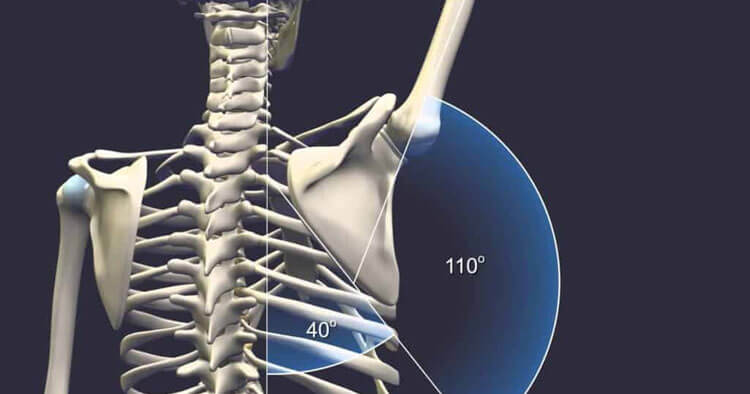Injury Rehabilitation and Training
Scapular Dyskinesis: Abnormal Shoulder Blade Motion
What Is The Scapula?
Your scapula (often referred to as your shoulder blade) is the triangular shaped bone that sits on your back at the rear of your shoulder. The shoulder blade is attached to the body only through its attachment to the clavicle (your collarbone) via the acromioclavicular joint (often shortened to being called the AC joint). Due to the limited bony support offered to the shoulder blade, your scapula is kept in place mainly by the work of surrounding muscles attaching on, or off it. The socket portion, of the ball and socket joint of the shoulder, is positioned on the outer edge of the scapula and helps form what is anatomically called the glenohumeral joint (the part of the body that most consider to be the shoulder). The position and movement of the shoulder blade is crucial for achieving full range of motion in the shoulder joint and keeping the ball and socket synchronized, which in turn helps avoid pain and injury in the shoulder joint whilst optimizing function. The term scapular dyskinesis refers to the alteration and lack of synchronization in normal motion, or positioning of the shoulder blade during coupled shoulder/shoulder blade (scapulohumeral) movements.
What Is Scapular Dyskinesis?
As mentioned above, scapular dyskinesis is the alteration in position, or motion of the shoulder blade during shoulder movements. Scapular dyskinesis is commonly a part of many injuries and pains involving the shoulder joint. Function of the shoulder in where scapular dyskinesis is present is often decreased. As alteration to scapula movement during shoulder movements fails to maintain ball and socket synchrony frequently with significant flow on effects.
Causes Of Scapular Dyskinesis?
Scapular dyskinesis is typically the result of a loss of muscular coordination around the shoulder blade. Coming about potentially from the presence of pain, or following injury that has the effect of altering activation patterns in shoulder blade muscles. Conversely altered, strength, flexibility and activation patterns in shoulder blade muscles can be the cause of both pain and injury.
Specifically but not exclusively the synchronization of the trapezius, rhomboid and serratus anterior muscles must exist for smooth shoulder blade motion during movements of the arm. Scapular dyskinesis may be contributed to from:
- Participation in overhead sports, hobbies or professions, examples of at risk activities include intense repetitive sports like tennis, volleyball and cricket or professions like electricians and painters.
- Injury to soft tissues, or bony structures of the shoulder.
- Poor posture, including tight muscles around the shoulder such as pectoralis major and pec minor. Postural changes may be the result of congenital variations, as well as adaptive changes. Adaptive changes around the spine and shoulder may result from repetitive occupational or recreational postures. A common causes of such change we see in our physio practice comes from an unbalanced weights training regime, where gym goers favour building the “mirror muscles” like their chest and biceps at the sacrifice of their back muscles.
Treatment Of Scapular Motion Issues
Physiotherapy treatment can usually help to successfully manage many presentations and causes of scapular dyskinesis. Your physio will generally focus on working to correct muscle imbalances and/or any underlying causes triggering the abnormal movement pattern of the scapula which clearly could include working to abolish pain. Frequently, addressing pec minor and posterior shoulder capsule tightness coupled with exercises to help increase serratus anterior, rhomboid, as well as lower, and mid trapezius activation is the cornerstone to treating many common presentations of scapular dyskinesis we see in our practice.
Disclaimer: Sydney Physio Clinic does not endorse any treatments, procedures, products mentioned. This information is provided as an educational service and is not intended to serve as medical advice. Anyone seeking specific orthopaedic advice or assistance on Scapular Dyskinesis: Abnormal Shoulder Blade Motion should consult his or her general practitioner, sports medicine specialist, physiotherapist or otherwise appropriately skilled practitioner.


